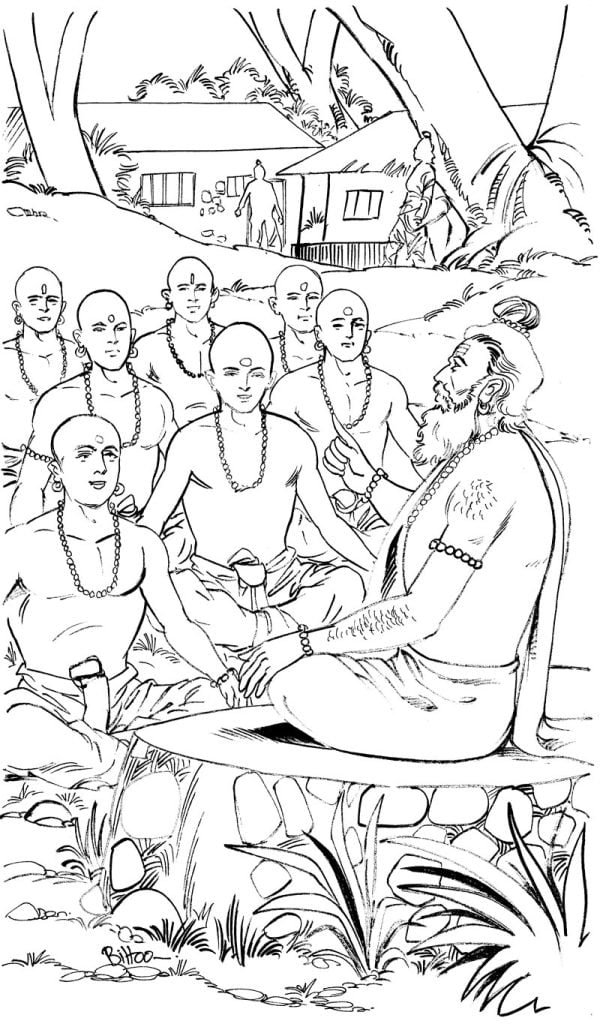Chanakya was the son of thef amed scholar and teacher, Chanak, born to him in the third century B.C. Some historians believe that Chanak was merely his guru and his name Chanakya was derivative of the guru’s name as a tribute to him. The fact is that no authentic record regarding the bio-data of the person of that period is available. The historians have their own theories built up upon the bits and peices of references and deductions.
But the unanimous opinion is that Chanak indeed was his primary teacher who taught him letters and the basics of the Sanskrit, the official language of the land of that age. As a student Chanakya was a quick learner. He was in appearance an ugly duckling. It is possible that to compensate it he pooled all his resources ino the education.
The student Chanakya
Chanakya studied all the scriptures as they were the only literature available then and were believed to be the sum total of all the knowledges worth learning. Young Chanakya become proficient in Vedas and Puranas, the profound storages of religious thought. He imbibed the wisdom of those scriptures as a stutdent on ‘As in what is’ basic. He was yet to diseminate the information he has received which required further education at a higher level. The learning had became the sole passion of Chanakya and he yearned for the higher education. On Chanak’s advice he set out of Taxila, a city situated on the bank of Sindhu river.’

Taxila was a centre of learning in that age. It had a great university where the thinkrs, scholars and prfessional teachers converged to impart knowledge to the students. Its fame attracted learners from all the kingdoms around. The sons of kings, royalty, nobles, rich scholars and Brahmins used to come their to get superior education.
Taxila is now in Pakistan. The excavations revealed that the university had facilities for ten thousand students. The number of teachers can well be imagined. There were chambers, halls, rooms and dormitories for holdings classes and lodging of the students.
The university offered an amazing range of subjects for studies which included Languages, Philosophy, Medicine, Astrology, Astronomy,
Gegoraphy, Grammars, Surgery, Agricultrue, Science, Religion, Occult Science, Yoga, Forestry and permission to conduct researches on various subjects.
The conoses had duration for upto eight years. The students came here at the age of about 15-16 years after learning basic, primer and middle high level of book studying. As general subjects Veda, archery, hunting, eletphant handling and more that a dozen other crafts besides the specialised branch of learning.
The University was generously funded and supported by kings and the rich people.
The graduates of Taxila university were greatly respected and valued all over the kingdoms of the land.
The excavation site of Taxila and the artefacts recovered draws hordes of tourists, historians and archaeologists constantly from all over the globe. It proves the Taxila story and the glorious past of our land is not figment of imagination.
So, Taxila University was where the knowledge hungry Chanakya had be. The record of his progress as a student is not available. But the kind of scholar he grew into is a poniter that he must have gone up rapidly as he had nothing else to do being a friendless boy due to his unattractive looks. He single mindedly concentrated on his studies and out shone other students. His classmates had to admit grudgingly that Chanakya was exceptionally brilliant but it got him no recognition. That was the period of the kings and the princess where common folk mattered little irrespective of the merits.
Chanakya left to himself studied all the written scriptures and the subjects taught in the University. He deeply studied the scriptures available on economic theories, state craft and social stuctures. Chanakya did his own analysis on the above subjects. Soon, it became apparent to all that Chanakya was academically growing up into a prize product of the University inspite of all the prejudices and drawbacks.

